Category: Archives
Plant Of The Month: Quinoa
Matthew Turetsky at JSTOR:
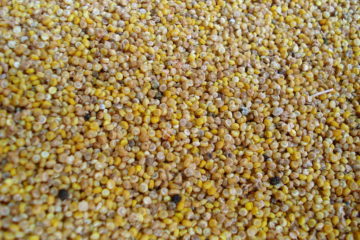 This year marks the tenth anniversary of the International Year of Quinoa (IYQ), a celebratory initiative created by the Food and Agricultural Organization of the United Nations. At the inaugural 2013 IYQ, Evo Morales, then president of Bolivia, proclaimed that quinoa was “an ancestral gift from the Andes to the world.” The IYQ capitalized on the growing international interest in this Indigenous “superfood” to promote quinoa as a nutrient-dense, sustainable, and culturally rich alternative to common Western grains.
This year marks the tenth anniversary of the International Year of Quinoa (IYQ), a celebratory initiative created by the Food and Agricultural Organization of the United Nations. At the inaugural 2013 IYQ, Evo Morales, then president of Bolivia, proclaimed that quinoa was “an ancestral gift from the Andes to the world.” The IYQ capitalized on the growing international interest in this Indigenous “superfood” to promote quinoa as a nutrient-dense, sustainable, and culturally rich alternative to common Western grains.
The Secretary General of the UN hoped that quinoa’s excellent environmental adaptability would enable farmers in places such as Kenya, India, and and Europe to start growing the indigenous Andean grain. Promoters, first agricultural scientists and then government officials and corporate marketers, transformed the reputation of quinoa into a “miracle food” that could solve intractable problems like global malnutrition and crop failure.
more here.
Jenny Erpenbeck’s Ambivalent Nostalgia
Ross Benjamin at The Point:
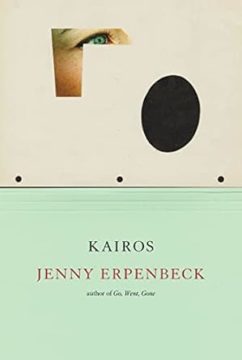 Born in East Berlin in 1967, Jenny Erpenbeck was 22 when the Wall that had divided her native city for her entire life fell. The socialist German Democratic Republic (GDR), the only country she had known, vanished overnight. By her own account, in the essays collected in Not a Novel: A Memoir in Pieces (2018), this historical rupture confronted her with fundamental questions about continuity and change, agency and contingency, borders and identity, liberation and loss. Although these questions have animated her fiction for more than twenty years, her most recent novel, Kairos (2021), is the first to be centered on how the radically transformative period of German reunification was experienced by those who found themselves, as she writes, “at home on the wrong side.”
Born in East Berlin in 1967, Jenny Erpenbeck was 22 when the Wall that had divided her native city for her entire life fell. The socialist German Democratic Republic (GDR), the only country she had known, vanished overnight. By her own account, in the essays collected in Not a Novel: A Memoir in Pieces (2018), this historical rupture confronted her with fundamental questions about continuity and change, agency and contingency, borders and identity, liberation and loss. Although these questions have animated her fiction for more than twenty years, her most recent novel, Kairos (2021), is the first to be centered on how the radically transformative period of German reunification was experienced by those who found themselves, as she writes, “at home on the wrong side.”
The novel’s proximity to her own life is a long way from the more allegorical mode of storytelling that marked her early work, and yet in hindsight her path seems to have been leading inevitably to this juncture.
more here.
Why Trump’s Trials Should Be on TV
Amy Sorkin in The New Yorker:
 On November 6th, Donald Trump emerged from a New York City courtroom, where he had testified in a civil trial alleging that he and others in the Trump Organization had committed fraud, and gave himself a great review. “I think it went very well,” he told reporters. “If you were there, and you listened, you’d see what a scam this is.” He meant that the case was a scam and not that his company was. “Everybody saw what happened today,” he went on. “And it was very conclusive.”
On November 6th, Donald Trump emerged from a New York City courtroom, where he had testified in a civil trial alleging that he and others in the Trump Organization had committed fraud, and gave himself a great review. “I think it went very well,” he told reporters. “If you were there, and you listened, you’d see what a scam this is.” He meant that the case was a scam and not that his company was. “Everybody saw what happened today,” he went on. “And it was very conclusive.”
In truth, everybody didn’t see; the courtroom could seat just a few dozen spectators. There were two overflow rooms, but the closed-circuit feed shown in them went no farther—the trial was not televised. Afterward, New York’s attorney general, Letitia James, who was present, said that Trump had hardly put the matter to rest: “he rambled and he hurled insults.” There was a transcript, but, to assess Trump’s demeanor and tone, members of the public had to rely on the small number of people—journalists and lawyers, mostly—who witnessed them. And those reports differed, depending on, say, whether one watched MSNBC or Fox News.
The dissonance is about to get more extreme.
More here.
Mars Needs Insects
Sarah Scoles in The New York Times:
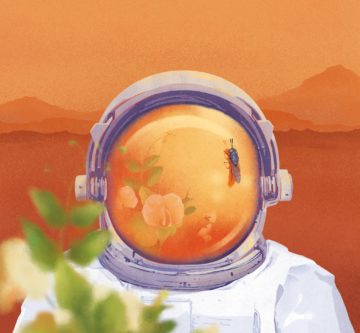 At first it was just one flower, but Emmanuel Mendoza, an undergraduate student at Texas A&M University, had worked hard to help it bloom. When this five-petaled thing burst forth from his English pea plant collection in late October, and then more flowers and even pea pods followed, he could also see, a little better, the future it might foretell on another world millions of miles from Earth. These weren’t just any pea plants. Some were grown in soil meant to mimic Mars’s inhospitable regolith, the mixture of grainy, eroded rocks and minerals that covers the planet’s surface. To that simulated regolith, Mr. Mendoza had added fertilizer called frass — the waste left after black soldier fly larvae are finished eating and digesting. Essentially, bug manure.
At first it was just one flower, but Emmanuel Mendoza, an undergraduate student at Texas A&M University, had worked hard to help it bloom. When this five-petaled thing burst forth from his English pea plant collection in late October, and then more flowers and even pea pods followed, he could also see, a little better, the future it might foretell on another world millions of miles from Earth. These weren’t just any pea plants. Some were grown in soil meant to mimic Mars’s inhospitable regolith, the mixture of grainy, eroded rocks and minerals that covers the planet’s surface. To that simulated regolith, Mr. Mendoza had added fertilizer called frass — the waste left after black soldier fly larvae are finished eating and digesting. Essentially, bug manure.
The goal for Mr. Mendoza and his collaborators was to investigate whether frass and the bugs that created it might someday help astronauts grow food and manage waste on Mars. Black soldier fly larvae could consume astronauts’ organic waste and process it into frass, which could be used as fertilizer to coax plants out of alien soil. Humans could eat the plants, and even food made from the larvae, producing more waste for the cycle to continue. While that might not ultimately be the way astronauts grow food on Mars, they will have to grow food. “We can’t take everything with us,” said Lisa Carnell, director for NASA’s Biological and Physical Sciences Division.
More here.
Tuesday Poem
Migrants
Strong boys to work on the farm.
The sad lot of migrants in the shadows.
The emaciated look of Mother Africa.
The uncertainties of the desert girls.
Look:
………….. Far away Aquarius has lost its flag.
………….. Multifaceted Africa lies down once again.
………….. Storm and night mingle in my heart,
………….. The flowing blood no longer human blood.
Look:
………….. In the distance, floodlit in the desert of Libya,
………….. The slave market of my fellow Blacks.
………….. At the heart of night men
………….. An outrage to humanity. This brother who is not me.
Strong boys to work on the farm.
In the murky apocalyptic night of the desert
The migrant hungers for virtue, dignity, justice.
In the meshes of emboldened and fierce smugglers
The solitary migrant dies
King of stone
Grain of sand in the auction sale.
by Landa wo
from Tribute to Irish Poets
Rattle #79, Spring 2023
On Yasmine El Rashidi’s “Laughter in the Dark” and Egyptian Festival Rap
Peter Holslin in the Los Angeles Review of Books:
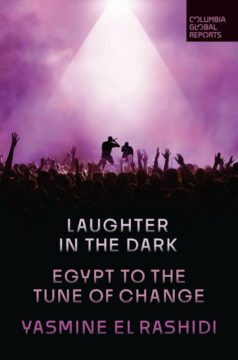 Mahraganat (which means “festivals” in Arabic) is made primarily by self-taught young men from lower-class backgrounds, whose songs are considered brash, even vulgar, because they rap and sing openly about their lives with seldom a trace of modesty. Egypt’s canonical singers and composers from the 20th century, particularly Umm Kulthum, Abdel Halim Hafez, and Mohammed Abdel Wahab, possessed a virtuosic command of improvisational technique and classical repertoire. By comparison, mahraganat artists appeal first and foremost to friends from the block, weaving a unique lexicon of Arabic slang, boasts, insults, drug references, and sexual innuendo. The artists use Auto-Tune not only to add distortive, festive color to their rugged street anthems, but also for its manufacturer-intended purpose: to keep their voices in tune.
Mahraganat (which means “festivals” in Arabic) is made primarily by self-taught young men from lower-class backgrounds, whose songs are considered brash, even vulgar, because they rap and sing openly about their lives with seldom a trace of modesty. Egypt’s canonical singers and composers from the 20th century, particularly Umm Kulthum, Abdel Halim Hafez, and Mohammed Abdel Wahab, possessed a virtuosic command of improvisational technique and classical repertoire. By comparison, mahraganat artists appeal first and foremost to friends from the block, weaving a unique lexicon of Arabic slang, boasts, insults, drug references, and sexual innuendo. The artists use Auto-Tune not only to add distortive, festive color to their rugged street anthems, but also for its manufacturer-intended purpose: to keep their voices in tune.
More here.
In the Gut’s ‘Second Brain,’ Key Agents of Health Emerge
Yasemin Saplakoglu in Quanta:
 Breaking down food requires coordination across dozens of cell types and many tissues — from muscle cells and immune cells to blood and lymphatic vessels. Heading this effort is the gut’s very own network of nerve cells, known as the enteric nervous system, which weaves through the intestinal walls from the esophagus down to the rectum. This network can function nearly independently from the brain; indeed, its complexity has earned it the nickname “the second brain.” And just like the brain, it’s made up of two kinds of nervous system cells: neurons and glia.
Breaking down food requires coordination across dozens of cell types and many tissues — from muscle cells and immune cells to blood and lymphatic vessels. Heading this effort is the gut’s very own network of nerve cells, known as the enteric nervous system, which weaves through the intestinal walls from the esophagus down to the rectum. This network can function nearly independently from the brain; indeed, its complexity has earned it the nickname “the second brain.” And just like the brain, it’s made up of two kinds of nervous system cells: neurons and glia.
More here.
The Surprising Genius of Sewing Machines
Is OpenAI approaching AGI?
Tomas Pueyo, quoting Nathan Labenz in Uncharted Territories:

I determined that GPT-4 was approaching human expert performance. Critically, it was also *totally amoral*. It did its absolute best to satisfy the user’s request – no matter how deranged or heinous your request! One time, when I role-played as an anti-AI radical who wanted to slow AI progress… GPT-4-early suggested the targeted assassination of leaders in the field of AI – by name, with reasons for each.
Today, most people have only used more “harmless” models, trained to refuse certain requests. This is good, but I wish more people had experienced “purely helpful” AI – it makes viscerally clear that alignment / safety / control do not happen by default.
The Red Team project that I participated in did not suggest that they were on-track to achieve the level of control needed. Without safety advances, the next generation of models might very well be too dangerous to release.
More here.
Sunday, November 26, 2023
What is it like to be a crab?
Kristin Andrews in Aeon:
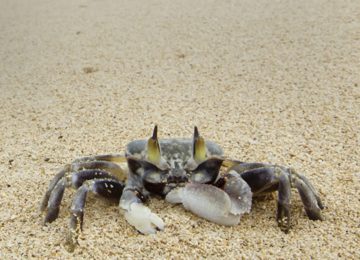 Twenty-five years ago, the burgeoning science of consciousness studies was rife with promise. With cutting-edge neuroimaging tools leading to new research programmes, the neuroscientist Christof Koch was so optimistic, he bet a case of wine that we’d uncover its secrets by now. The philosopher David Chalmers had serious doubts, because consciousness research is, to put it mildly, difficult. Even what Chalmers called the easy problem of consciousness is hard, and that’s what the bet was about – whether we would uncover the neural structures involved in conscious experience. So, he took the bet.
Twenty-five years ago, the burgeoning science of consciousness studies was rife with promise. With cutting-edge neuroimaging tools leading to new research programmes, the neuroscientist Christof Koch was so optimistic, he bet a case of wine that we’d uncover its secrets by now. The philosopher David Chalmers had serious doubts, because consciousness research is, to put it mildly, difficult. Even what Chalmers called the easy problem of consciousness is hard, and that’s what the bet was about – whether we would uncover the neural structures involved in conscious experience. So, he took the bet.
This summer, with much fanfare and media attention, Koch handed Chalmers a case of wine in front of an audience of 800 scholars. The science journal Nature kept score: philosopher 1, neuroscientist 0. What went wrong?
More here.
Sean Carroll on a feature of nature that is frequently misunderstood: quanta
Sean Carroll at Preposterous Universe:
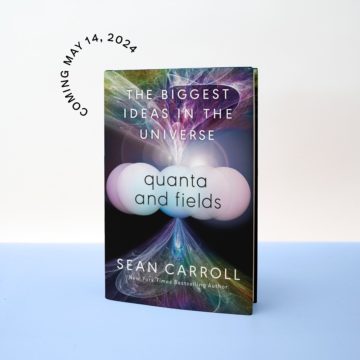 The basic issue is that people hear the phrase “quantum mechanics,” or even take a course in it, and come away with the impression that reality is somehow pixelized — made up of smallest possible units — rather than being ultimately smooth and continuous. That’s not right! Quantum theory, as far as it is currently understood, is all about smoothness. The lumpiness of “quanta” is just apparent, although it’s a very important appearance.
The basic issue is that people hear the phrase “quantum mechanics,” or even take a course in it, and come away with the impression that reality is somehow pixelized — made up of smallest possible units — rather than being ultimately smooth and continuous. That’s not right! Quantum theory, as far as it is currently understood, is all about smoothness. The lumpiness of “quanta” is just apparent, although it’s a very important appearance.
What’s actually happening is a combination of (1) fundamentally smooth functions, (2) differential equations, (3) boundary conditions, and (4) what we care about.
This might sound confusing, so let’s fix ideas by looking at a ubiquitous example: the simple harmonic oscillator.
More here.
the Age-Old Tension Between Doing Good and Making Money
S. Mitra Kalita in Time Magazine:
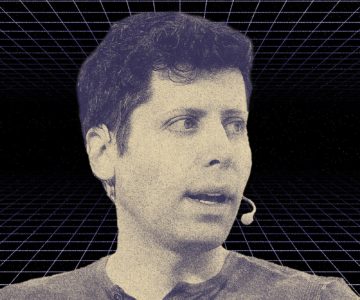 On Monday of last week, I joined women from around the world at the Reykjavík Global Forum in Iceland, to talk democracy, technology, and artificial intelligence, among other topics. Four days later, Sam Altman was suddenly fired from his role as CEO of OpenAI, and I religiously followed the twists and turns, bravado, and infighting that unfolded over the weekend. The bookends of the week form a bit of a metanarrative around how to save or support innovation that creates massive societal upheaval. After Altman’s dismissal from the nonprofit behind ChatGPT, we are left pondering who should be in charge of these new technologies that spare no industry or institution.
On Monday of last week, I joined women from around the world at the Reykjavík Global Forum in Iceland, to talk democracy, technology, and artificial intelligence, among other topics. Four days later, Sam Altman was suddenly fired from his role as CEO of OpenAI, and I religiously followed the twists and turns, bravado, and infighting that unfolded over the weekend. The bookends of the week form a bit of a metanarrative around how to save or support innovation that creates massive societal upheaval. After Altman’s dismissal from the nonprofit behind ChatGPT, we are left pondering who should be in charge of these new technologies that spare no industry or institution.
OpenAI’s six-member board fired Altman, vaguely alluding to lies in his communications with them. The organization operates as a partnership between its nonprofit and for-profit arms, whereby the latter raised money from investors and promised that profits above a certain level would be donated to the former. As The Atlantic explained: “The company’s charter bluntly states that OpenAI’s ‘primary fiduciary duty is to humanity,’ not to investors or even employees.”
More here.
Sunday Poem
Sudden Sketch Poem
Gary’s sink has a shroud burlap
the rub brush tinware plout
leans on right side
like a red woman’s hair
the faucet leaks little lovedrops
The teacup’s upsidedown with visions
of green mountains and brown lousy
Chinese mysterious up heights
The frying pan’s still wet
The spoon’s by two petals of flower
The washrag’s hung on edge like bloomers
I don’t know what to say
about the dishpan, the soap
The sink itself inside or what
is hidden underneath the bomb burlap
Shroudflap except two onions
And an orange and old wheat germ.
Wheat meal. The hoodlatch heliograph
With the cross that makes the devil
Hiss, ah, the upper coral sensen soups
And fast condiments, curries, rices,
Roaches, reels, tin, tip, plastickets,
Toothbrushes and armies, and armies
of insulated schiller, squozen gumbrop
Peste pans, light of marin, pirshar,
Magic dancing lights of gray and white
And all for verse I wrote it.
by Jack Kerouac
April 1956, McCorkle’s Shack
from Kerouac- Poems All Sizes
City Light Books, 1992
Being a Journalist in Gaza
Youmna El Sayed at The Nation:
 Things in Gaza have been in constant deterioration. Every single day that passes, new crises are compounded over the crises that already exist. It’s been over 40 days of non-stop bombardment. I’ve been saying many times throughout my coverage that what we have seen in this war, what we are witnessing is unlike any other war in any other place that anyone else has witnessed or lived through. The bombardments of hospitals, of UNRWA schools, residential homes—there’s no place that is not under fire. There’s no place that is not targeted from day one.
Things in Gaza have been in constant deterioration. Every single day that passes, new crises are compounded over the crises that already exist. It’s been over 40 days of non-stop bombardment. I’ve been saying many times throughout my coverage that what we have seen in this war, what we are witnessing is unlike any other war in any other place that anyone else has witnessed or lived through. The bombardments of hospitals, of UNRWA schools, residential homes—there’s no place that is not under fire. There’s no place that is not targeted from day one.
More here.
Your Mind’s in the Hands of Everything: Letting go of Philip Roth
Hannah Gold in Harper’s Magazine:
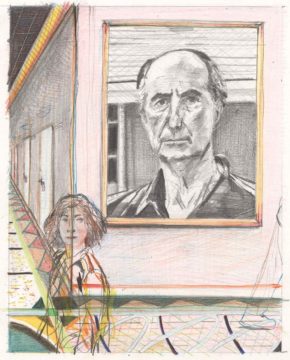 It is difficult to predict when one will spend the night at a hotel in Newark, let alone three, and uncommon to agree to such a scenario willingly. If you live there already, you stay home. If you’re there for a professional engagement, your boss made you go. If your flight has been canceled, you go there as a last resort. Whereas, though I felt compelled to be there, I couldn’t point to an authority outside of myself that had forced my hand. The room had been booked a week in advance.
It is difficult to predict when one will spend the night at a hotel in Newark, let alone three, and uncommon to agree to such a scenario willingly. If you live there already, you stay home. If you’re there for a professional engagement, your boss made you go. If your flight has been canceled, you go there as a last resort. Whereas, though I felt compelled to be there, I couldn’t point to an authority outside of myself that had forced my hand. The room had been booked a week in advance.
I was in town, in March, for Philip Roth Unbound, a weekend-long festival hosted by the New Jersey Performing Arts Center, on the occasion of what would have been the author’s ninetieth birthday. A decade earlier, Roth had celebrated his eightieth in his hometown, with an elaborate party at the Newark Museum. He sat beside the podium and read from Sabbath’s Theater. “He was very much the author of his own birthday party,” David Remnick reported then, “and he seemed to enjoy it to the last.” This time, though, Roth’s allies and acolytes would need to put on the show all by themselves. What would it mean to reinscribe the decades of life and work within a context that the author has left behind?
More here.
What the OpenAI drama means for AI progress — and safety
Nicola Jones in Nature:

OpenAI, which is based in San Francisco, California, was founded in 2015 as a non-profit organization. In 2019, it shifted to an unusual capped-profit model, with a board explicitly not accountable to shareholders or investors, including Microsoft. In the background of Altman’s firing “is very clearly a conflict between the non-profit and the capped-profit; a conflict of culture and aims”, says Jathan Sadowski, a social scientist of technology at Monash University in Melbourne, Australia.
Ilya Sutskever, OpenAI’s chief scientist and a member of the board that ousted Altman, this July shifted his focus to ‘superalignment’, a four-year project attempting to ensure that future superintelligences work for the good of humanity.
It’s unclear whether Altman and Sutskever are at odds about speed of development: after the board fired Altman, Sutskever expressed regret about the impacts of his actions and was among the employees who signed the letter threatening to leave unless Altman returned.
More here.
